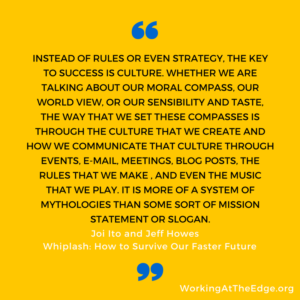 …a map implies a detailed knowledge of the terrain, and the existence of an optimum route; the compass is a far more flexible tool and requires the user to employ creativity and autonomy in discovering his or her own path. The decision to forfeit the map in favor of the compass recognizes that in an increasingly unpredictable world moving ever more quickly, a detailed map may lead you deep into the woods at an unnecessarily high cost. ~Joi Ito and Jeff Howe, Whiplash: How to Survive our Faster Future
…a map implies a detailed knowledge of the terrain, and the existence of an optimum route; the compass is a far more flexible tool and requires the user to employ creativity and autonomy in discovering his or her own path. The decision to forfeit the map in favor of the compass recognizes that in an increasingly unpredictable world moving ever more quickly, a detailed map may lead you deep into the woods at an unnecessarily high cost. ~Joi Ito and Jeff Howe, Whiplash: How to Survive our Faster Future
I was drawn to the powerful metaphors of the map and compass upon reading Whiplash, and have been thinking about how the metaphors apply to both leadership and learning. Too much of education has been about the map – following a prescribed path, learning “delivered to” the learner, standards, grade levels, leadership hierarchies, and on and on. I’m unsettled around these school-centered, map-like ideas, and I suppose that is why so much of our work in Salisbury has shifted focus to learner-centered environments (young and old learners) and learner-centered leadership.
Learner-centered embraces the compass over the map, and it is surely a better fit with our values about learning and leading. The system alone cannot be most effective providing the “map” as we know that every learner and every leader is a unique individual, naturally drawn to exercise their own agency. When systems and leadership solely reflect the map metaphor, they rob the learner of agency and reinforce a culture of standardization, “normal,” and “average.” They also rob learners of opportunities to develop the agility so needed in a world – now and in the future – of exponential change.
After reading about the idea of compasses over maps, I began to make connections to what we are doing in Salisbury with our Profile of a Graduate and Learning Beliefs. Rather than developing the traditional strategic plan (what some might consider a map), we worked with all of our stakeholders to define our compass – the Profile. Some may look at the Profile and feel it is really nothing but a set of terminology that has a wide array of meaning – just too messy. But collectively, the concepts and terminology – what we believe we should be working toward – really represents our compass, guiding our movement forward.
How have we started to use our compass? This past school year, a professional learning cohort was established (led by our Assistant Superintendent, Lynn Fuini-Hetten), consisting of teacher leaders, principals and central office leaders. This group of 23 formally met three times as a full group, and two additional times in building level teams. Between formal meetings, there were informal opportunities to explore ideas and shift mindsets. The learning valued the five elements of our learning beliefs with the Profile serving as the compass for the development of individual building action plans. It was exciting to see how our principals, teacher leaders and central office staff embraced the messiness of the “compass” and developed learning opportunities unique to the climate, culture and needs of the building – personalized opportunities that furthered our collective goals. For further detail, check out this presentation.
The work that our school leaders and teacher leaders accomplished this year was a result of creating a district and school culture that embraced the uncertainty and autonomy of the “compass.” Ito and Howes celebrate this at the end of Chapter 3:
Instead of rules or even strategy, the key to success is culture. Whether we are talking about our moral compass, our world view, or our sensibility and taste, the way that we set these compasses is through the culture that we create and how we communicate that culture through events, e-mail, meetings, blog posts, the rules that we make , and even the music that we play. It is more of a system of mythologies than some sort of mission statement or slogan. ~Joi Ito and Jeff Howes, Whiplash: How to Survive our Faster Future
The compass over the map is more effective whether we are talking about learning or leadership. It not only produces better outcomes, but it provides the space for learners and leaders to take ownership of their work and to practice agility during uncertain conditions.
How is your leadership like a map? Like a compass? Is it either/or? Are there times when a map is better than a compass?
Connect with Randy on Twitter, the TLTalkRadio podcast, and on the Shift Your Paradigm podcast!
Get new content delivered to your inbox and the ebook 3 Key Principles of Digital Transformation. The ebook contains valuable information from my experience leading a digital transformation and working with a variety of stakeholders over the past decade.
- A silver lining - January 22, 2022
- Is our use of tech working against us? 🤔 - September 8, 2021
- What’s NOT going to change in the next 10 years? 🤔 - September 7, 2021
[…] “delivered to” the learner, standards, grade levels, leadership hierarchies, and on and on,” said Ziegenfuss. He added, “Learner-centered embraces the compass over the map.” Randy sees agency as key to […]